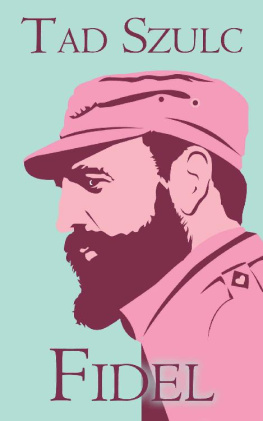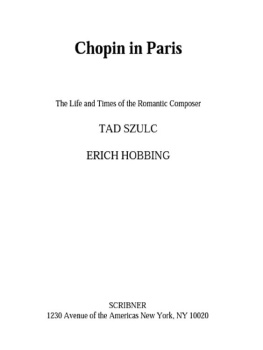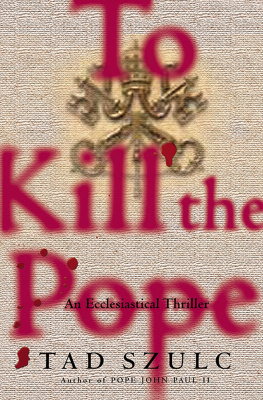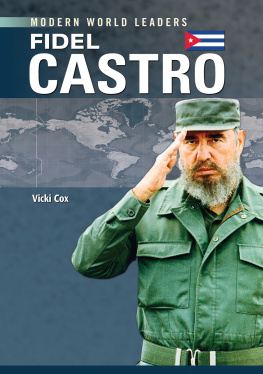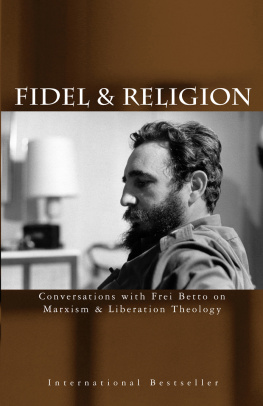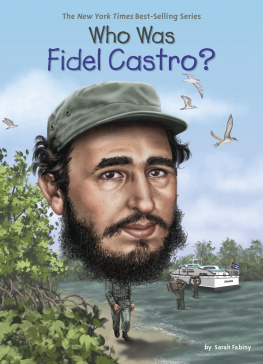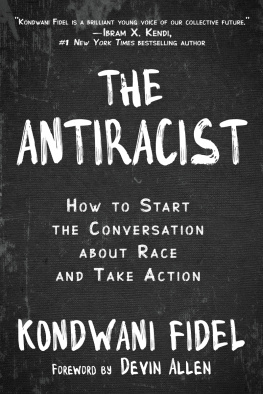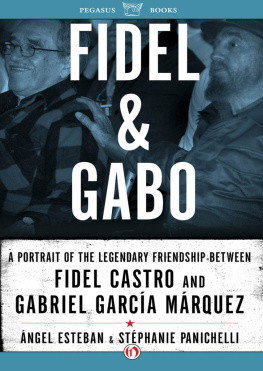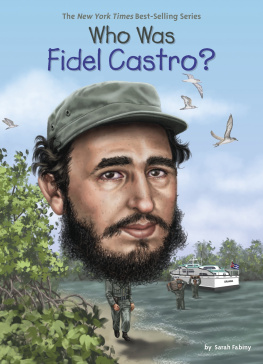Tad Szulc - Fidel: A Critical Portrait
Here you can read online Tad Szulc - Fidel: A Critical Portrait full text of the book (entire story) in english for free. Download pdf and epub, get meaning, cover and reviews about this ebook. year: 2000, publisher: HarperCollins, genre: Politics. Description of the work, (preface) as well as reviews are available. Best literature library LitArk.com created for fans of good reading and offers a wide selection of genres:
Romance novel
Science fiction
Adventure
Detective
Science
History
Home and family
Prose
Art
Politics
Computer
Non-fiction
Religion
Business
Children
Humor
Choose a favorite category and find really read worthwhile books. Enjoy immersion in the world of imagination, feel the emotions of the characters or learn something new for yourself, make an fascinating discovery.
Fidel: A Critical Portrait: summary, description and annotation
We offer to read an annotation, description, summary or preface (depends on what the author of the book "Fidel: A Critical Portrait" wrote himself). If you haven't found the necessary information about the book — write in the comments, we will try to find it.
Fidel: A Critical Portrait — read online for free the complete book (whole text) full work
Below is the text of the book, divided by pages. System saving the place of the last page read, allows you to conveniently read the book "Fidel: A Critical Portrait" online for free, without having to search again every time where you left off. Put a bookmark, and you can go to the page where you finished reading at any time.
Font size:
Interval:
Bookmark:
FIDEL
Tad Szulc
Copyright 1986 by Tad Szulc
This book is for Marianneagain

Havana
Pinar del Rolarge percentage of Moncada recruits came from here
here Isle of Pines (now Isle of Youth), Castro and company imprisoned here, 19531955
Bay of Pigs (or Playa Girn), April 17, 1961, exiles' invasion
Santa Clara, capital of Las Villas provinceconquest climaxes Che's campaign
campaign Escambray Mountainsnon-Castro guerrillas in 1958/site of anti-Castro guerrillas, 19601965
Bayamosimultaneous rebel attack on barracks, July 26, 1953
Granma landingLos Cayuelos, December 2, 1956
Alegra de Po battlefieldfirst Castro defeat
La PlataFidel's headquarters atop Sierra Maestra
Celia's home
First rebel victory
BirnFidel's birthplace
SantiagoMoncada barracks attack, July 26, 1953
Sierra CristalRal Castro's "second front"
GuantnamoU.S. naval base
Tuxpan, Mexico Granma departure point, November 25, 1955
CONTENTS
INTRODUCTION
President Fidel Castro Ruz of Cuba asked me the following question as we stood in his office winding up a long conversation shortly after midnight on February 11, 1985:
"Will your political and ideological viewpoint allow you to tell objectively my story and the revolution's story when the Cuban government and I make the necessary material available to you?" He added: "We would be taking a great risk with you."
This was at the end of five lengthy, consecutive meetings I had with President Castro at the Palace of the Revolution in Havana as I prepared to write this "portrait," and we had touched on an immense variety of themes concerning him and his life story. My reply to President Castro's question was that I didn't think total objectivity existed, but that I would commit myself to approaching this project with the greatest possible honesty. I remarked that since we both were honorable men, his ideology and mine, differing in the most absolute fashion as they did, should not interfere with the writing of an honest book. President Castro said, "You may paint me as a devil so long as you remain objective and you let my voice be heard," and we warmly shook hands.
I had my first conversations with Fidel Castro in 1959, shortly after his revolution triumphed, when I was in Havana as a correspondent for The New York Times . In 1961, I accompanied him on a tour of the Bay of Pigs battlefield. I returned to Cuba in January 1984 to interview President Castro for Parade magazine, and the idea of this book was born during a very long weekend we spent together in Havana and the countryside in endless discussions. I had reminded him that there was no serious biography of him or comprehensive study of the revolution, and that he owed it to history to remedy this lack.
We went on exchanging messages through Cuban diplomats in Washington during the balance of 1984, and we immediately agreed that this should not be an official or authorized biography or portrait. Instead, it would be an independent project with collaborative support by President Castro and his associates as well as access to written materials of the revolution. I spent a month in Havana early in 1985, holding a series of meetings with President Castro, then my wife and I set up shop in a house we rented in Havana for six months between March and August (where we were visited by President Castro). Our understanding did not require that the manuscript be seen by President Castro prior to publication, and therefore it was not. I am certain that when he does read it, he will disagree with many of my opinions and conclusions but that he will find the pledge of honesty to have been met. He knows, of course, that others may see him differently than he sees himself, and for me to be critical is not a violation of his trust.
Clearly, this is not a definitive biography, principally because President Castro is alive and has not completed his labors. Perhaps only the next generation of historians can attempt a full-fledged biography of this extraordinary personage. This "Critical Portrait," therefore, seeks to capture his personality and the story of his life as it is possible to reconstruct at this stage. It is not meant to be a history of the Cuban revolution, or of Cuban-American relations, and this is why I have avoided discussing in depth the achievements and the problems of the revolution. Nevertheless, Fidel Castro and his revolution are inseparable, and this portrait was sketched against the broader background of contemporary Cuban history.
To write it, I interviewed scores of Fidel Castro's friends, associates, and comrades-in-arms, in addition to my conversations with him. I have listened to a great many Cubans who have insight into the very complex personality of Fidel Castro and into the process of the revolution. I was able to see President Castro in action on occasions ranging from receptions at the Palace of the Revolution to a tour of the prison on the Isle of Youth (formerly Isle of Pines), where he had spent nearly two years as a prisoner of the Batista regime. I revisited the Bay of Pigs, and my wife and I climbed the Sierra Maestra to Fidel Castro's wartime command post to gain a sense of the environment in which he fought; we inspected the landing spot of the Granma that brought him and his rebels from Mexico, and the nearby battlefield where Fidel Castro's revolution almost ended three days after it began.
Among Cuban personalities I have interviewed and who have made this book possible because of the time they sacrificed were Vice-President of Cuba and Education Minister Jos Ramn Fernndez lvarez; Pedro Miret Prieto, a member of the Political Bureau of the Communist party and one of President Castro's oldest associates; Vice-President Carlos Rafael Rodrguez; Culture Minister and Political Bureau member Armando Hart Dvalos; former Interior Minister and close comrade-in-arms Ramiro Valds Mendez; Faustino Prez and Universo Snchez, who were with Fidel Castro at the moment of near disaster; Alfredo Guevara, whose friendship with Castro goes back to their university days and their first revolutionary experiences; former Political Bureau member and Transport Minister Guillermo Garca, who was the first Sierra Maestra peasant to join the Rebel Army; Blas Roca, former secretary general of the Communist party, and Fabio Grobart, one of its founders in 1925; Melba Hrnandez, who fought with Fidel in the Moncada attack and was among the first members of the revolutionary movement; Vilma Espn, president of the Cuban Women's Federation and member of the Political Bureau (and wife of Ral Castro); and Conchita Fernndez, who was Fidel Castro's personal secretary during the first years of the revolution.
It is impossible to list here all the Cuban officials, friends, and acquaintances in political and cultural fields who were of immense assistance in my research. Foreign dioplomats served as important guides, and among them I wish to mention Clara Nieto Ponce de Lon, former ambassador of Colombia in Cuba and, during our stay, director of the UNESCO office. In the Sierra Maestra, peasants who knew Castro during the war provided remarkable accounts of those days. Finally, our research and interviews in Havana were coordinated by Alfredo Ramirez Otero and Walfredo Garciga of the Ministry of External Affairs.
In the United States, conversations with Jorge Dominguez of Harvard University; Nelson Valds of the University of New Mexico; Wayne S. Smith, who served as head of the U.S. Interests Section in Havana; George Volsky, who is a journalist in Miami and a leading expert on Cuba; and Max Lesnick, a university friend of Castro's and now a publisher in Miami were immensely useful. Numerous Cubans who knew Castro in boarding school and at the university, and are now exiled in the United States shared their recollections. My special gratitude is to The Hon. Ambler H. Moss, dean of the Graduate School of International Studies at the University of Miami, and to Dr. Jaime Suchlicki, director of the Institute of Inter-American Studies at the University of Miami, for superb research and intellectual support. Gabriela Rodrguez was a most intelligent and resourceful researcher. My wife, Marianne, lived through all of it: meetings with President Castro, entertaining Cuban friends in Havana, climbing Cuban mountains, organizing masses of material we brought back from Cuba, researching in Washington, and reading, improving and editing the manuscript.
Next pageFont size:
Interval:
Bookmark:
Similar books «Fidel: A Critical Portrait»
Look at similar books to Fidel: A Critical Portrait. We have selected literature similar in name and meaning in the hope of providing readers with more options to find new, interesting, not yet read works.
Discussion, reviews of the book Fidel: A Critical Portrait and just readers' own opinions. Leave your comments, write what you think about the work, its meaning or the main characters. Specify what exactly you liked and what you didn't like, and why you think so.

